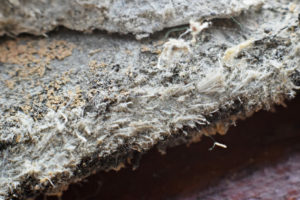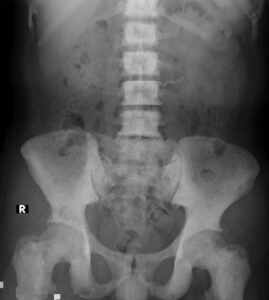Asbestos-Related Diseases
Exposure to asbestos fibers can lead to diseases like lung cancer, mesothelioma, and asbestosis 10-50 years later. Many of these asbestos-related diseases are aggressive and life-threatening, but treatments can help patients live longer. Lung Cancer Group can connect patients with financial aid so they can afford treatment for asbestos-related diseases.
How Asbestos Exposure Leads to Diseases
 Asbestos exposure is a major risk factor for many diseases, including lung cancer.
Asbestos exposure is a major risk factor for many diseases, including lung cancer.
When people work with asbestos-containing materials, they inhale asbestos fibers. The fibers can get stuck in the body and irritate healthy tissue. After 10-50 years, this irritation can cause asbestos-related diseases to form.
These health conditions are commonly referred to as asbestos-related diseases.
- Lung cancer
- Asbestosis (a painful lung disease)
- Mesothelioma (cancer that affects linings of organs)
- Pleural plaques (protein buildup in lung lining)
- Other cancers and diseases
Asbestos-related diseases can be devastating, but Lung Cancer Group is here to help. Our team can retrieve financial compensation for you and your family if you were diagnosed with lung cancer, mesothelioma, or another asbestos-related disease.
The money we secure for you can help pay for medical bills and any other expenses you face. Get started now with a free case review.
- Access Financial Aid and Justice
- Learn About Your Options
- Contact Us for Free

Types of Asbestos-Related Diseases
Asbestos exposure can cause a wide range of health problems. There are two main types of asbestos-related lung diseases: benign (noncancerous) ones and malignant (cancerous) ones. Learn about these illnesses below.
Malignant Asbestos-Related Diseases
Malignant asbestos-related diseases are cancers. Typically, the prognosis (health outlook) for those diagnosed is poor, since many of these asbestos-caused cancers are aggressive.
However, early detection and treatment of malignant asbestos-related diseases can help some patients live longer.
Lung Cancer


Symptoms and signs of lung cancer only typically emerge once the disease is advanced. Doctors can use will use physical exams, lung function tests, chest X-rays, and biopsies to diagnose you. Unfortunately, most patients are diagnosed in a late stage when the cancer is harder to treat.
Signs and symptoms of lung cancer may include:
- A cough that doesn’t go away
- Bone pain
- Coughing up blood
- Chest pain
- Fatigue
- Unintentional weight loss
The average 5-year survival rate for lung cancer is 26%, meaning just over 1 in 4 patients are still alive 5 years after being diagnosed.
Get help now if you were diagnosed with lung cancer after asbestos exposure: Call (877) 446-5767.
Mesothelioma
Malignant mesothelioma is a deadly cancer that happens in the mesothelium, the thin tissue layer that projects most of your internal organs, after asbestos exposure. A person can develop one of four types of mesothelioma depending on where asbestos fibers get stuck.
There are four main types of mesothelioma:
- Pleural mesothelioma is the most common type of mesothelioma. It develops in the pleura or the lining of the lungs. Symptoms include shortness of breath, pain in the chest and back, difficulty breathing, shortness of breath, and weight loss.
- Pericardial mesothelioma affects the tissue surrounding the heart. It can cause symptoms like chest pains and difficulty breathing. It’s very rare and has the worst prognosis of any type.
- Peritoneal mesothelioma occurs in the peritoneum, the membrane that lines your abdominal organs and abdomen. The most common symptoms include fluid buildup and pain in the abdomen, a painful mass in your pelvic area, and bulging or swelling in your abdomen.
- Testicular mesothelioma is a rare type of mesothelioma that starts in the testicle lining. It causes swelling or masses on testicles.
The overall 5-year survival rate for mesothelioma is 10%, according to the American Society of Clinical Oncology (ASCO). However, a patient’s prognosis can vary greatly by each mesothelioma type and other factors.
Ovarian Cancer
Ovarian cancer is cancer that affects the ovaries. The American Cancer Society (ACS) notes that studies have linked some cases of ovarian cancer back to asbestos exposure.
Women could be at risk of asbestos-related ovarian cancer if they used talcum powder. Talcum powder is made from talc, a naturally occurring mineral often found near asbestos deposits, so cross-contamination could have happened.
Johnson’s baby powder (which was made up of talc) was found to have contained asbestos fibers as recently as 2019, and after public backlash, the company stopped making or selling talc-based baby powder in 2023.
The company currently faces over 40,000 lawsuits from those claiming asbestos in the baby powder caused ovarian cancer.
Like lung cancer and mesothelioma, ovarian cancer may not have any symptoms when it first develops.
Over time, various symptoms may emerge with ovarian cancer, including:
- Abdominal swelling or bloating
- Back pain
- Bowel habit changes, such as constipation
- Discomfort in the pelvis
- Not feeling hungry
- Weight loss
For ovarian cancer, the average 5-year survival rate is over 50%. Some types of ovarian cancer, such as germ cell tumors of the ovary, have 5-year survival rates of up to 93%.
Laryngeal Cancer
Laryngeal cancer occurs when cancer cells form in the tissues of the larynx, the area of the throat that contains the vocal cords.
Common signs and symptoms of laryngeal cancer include:
- A cough or sore throat that does not go away
- Ear pain
- Hoarseness or a change in the voice
- A lump in the throat or neck
5-year survival rates for laryngeal cancer range from 35% to 77% depending on which part of the larynx has become cancerous.
Other Types of Cancer


These cancers may include:
- Colon cancer
- Rectal cancer
- Stomach and gastrointestinal cancer
- Throat or pharyngeal cancer
Our team can help you retrieve financial compensation for asbestos-caused cancers right now. Get a free case review and learn more.
- Access Financial Aid and Justice
- Learn About Your Options
- Contact Us for Free



Benign Asbestos-Related Diseases
Benign asbestos-related diseases are not cancerous, but many can still be fatal if you don’t get prompt treatment. Learn about benign asbestos-related diseases below.
Asbestosis
Also called diffuse pulmonary fibrosis, asbestosis is a chronic respiratory disease caused by breathing in asbestos fibers. It causes severe lung damage. Over time, the lungs become irritated and stiff, making breathing difficult and painful.
Symptoms of asbestosis include:
- Breathlessness
- Crackling sounds in your lungs when you inhale
- A dry, persistent cough
- Toes and fingertips that look rounder and wider than usual (clubbing)
Severe cases of asbestosis cause the lungs and heart to fail, according to the Center for Asbestos-Related Diseases in Libby, Montana.
Pleural Plaques
Pleural plaques happen when a protein called collagen builds up in the pleura, the thin tissue layer that covers your lungs. This is the most common asbestos-related disease, according to the Agency for Toxic Substances and Disease Registry (ATSDR).
Pleural plaques do not cause any symptoms and are harmless. However, thick and widespread pleural plaques may indicate a more serious pleural disease, such as mesothelioma.
Pleural Effusions
A pleural effusion is a buildup of fluid between the tissue layers that line the chest cavity and lungs. They are often symptoms of asbestos-related cancers like lung cancer and pleural mesothelioma.
Symptoms of pleural effusions can include:
- Cough
- Fever and chills
- Hiccups
- Rapid breathing
- Chest pain that gets worse with deep breaths or coughing


Pericardial effusion symptoms include chest pain, lightheadedness, shortness of breath, and discomfort when breathing while lying down. Signs of peritoneal effusions may include swelling or pain in the abdomen, weight gain, chest pain, trouble breathing, fatigue, and loss of appetite.
Medical treatments can help drain effusions and ease symptoms. Afford treatments with our team’s help: Call (877) 446-5767 now.
Other Benign Asbestos Diseases
Asbestos exposure can cause other benign conditions.
These conditions include:
- Atelectasis: This is the partial or complete collapse of a lung. It happens when the alveoli — tiny sacs in the lung where oxygen and carbon dioxide are exchanged — become filled with fluid or deflated. Atelectasis can make breathing challenging.
- Chronic obstructive pulmonary disease (COPD): This is a chronic inflammatory lung condition that obstructs airflow from the lungs. Symptoms include mucus production, cough, breathing difficulty, and wheezing.
- Diffuse pleural thickening: This can happen when scarring thickens the lung lining and chest wall. When this happens, your lungs cannot expand like they used to, leaving you with decreased lung function.
What Is the Prognosis for Asbestos-Related Diseases?
The prognosis or expected outcome for asbestos diseases depends on whether the condition is benign or malignant.
- Benign asbestos diseases may or may not be fatal. For example, pleural effusions typically cause pain but can be treated, while asbetosis is only treated using pain-relieving options and will worsen.
- On the other hand, malignant asbestos diseases like lung cancer usually have a poor prognosis. These conditions are especially hard to treat if people do not realize they are ill until the cancer has metastasized or spread throughout the body.
Doctors can determine your mesothelioma prognosis based on which asbestos-related disease you have and how advanced it is at the time of diagnosis. From there, they can recommend treatments to help you live as long as possible with the least amount of pain.
Get Compensation for an Asbestos-Related Disease
The health effects of asbestos can be devastating. If you suspect you have lung cancer or another illness related to asbestos exposure, talk to your doctor. They can run tests to properly diagnose you and from there, help you get treatments.
However, medical treatments for asbestos-related diseases can be expensive. For example, mesothelioma can cost $500,000 or more to treat.
The good news is that Lung Cancer Group may be able to help you recover financial compensation to pay medical bills and other expenses. Get a free case review now to learn if you qualify.
Asbestos-Related Diseases FAQs
How does asbestos cause diseases?
Stray asbestos fibers can get lodged in the lungs and other body parts when people inhale them. Over time, asbestos fibers build up and cause tissue scarring and inflammation.
This can eventually cause healthy cells to become cancerous or lead to long-term but benign health problems like asbestosis.
What are the 4 major asbestos-related diseases?
Four of the most notable asbestos-related diseases are mesothelioma, lung cancer, pleural plaques, and asbestosis.
All of these diseases can be life-threatening without prompt medical treatment, except for pleural plaques which are harmless.
Why was asbestos used if it could cause diseases?
Asbestos-based products were used from the 1930s to the early 1980s because manufacturers hid the risks and emphasized the benefits of using them. Asbestos was fireproof, highly durable, and a great insulator.
Asbestos was found in many homes and building materials. Commonly used asbestos building products included insulation, roofing, and cement. Asbestos was also used on many ships, putting those who served on them (as well as shipyard workers) at risk.
The passage of the Toxic Substances Control Act of 1976 and other acts in the 1980s put limits on asbestos and other carcinogens. As a result, most industries stopped using asbestos.
What are common asbestos disease symptoms?
Asbestos exposure can cause symptoms like coughing, shortness of breath, weight loss, appetite loss, and chest pain. However, you might not notice any signs of asbestos-caused diseases until decades after your exposure.
If you believe you’ve been exposed to asbestos, talk to your health care provider about steps you can take to protect yourself and slow the progress of asbestos-related diseases.
Are all asbestos diseases curable?
No, asbestos diseases are generally not curable. Once you inhale asbestos fibers, they will remain in your lungs forever, leading to irreversible scarring and inflammation.
However, it’s often possible to get treatments that can help you live for a long time with asbestos-related diseases and ease your symptoms. Some patients have even lived for 20 years or more with severe asbestos-caused illnesses like mesothelioma.
Can you get compensation for a benign asbestos disease?
Yes, you can potentially get compensation for benign asbestos diseases like asbestosis. Contact Lung Cancer Group to learn more about your options.
Do all types of asbestos cause disease?
Yes. All types of asbestos — including actinolite, amosite, anthophyllite, tremolite, crocidolite, amphibole, and chrysotile asbestos – are carcinogenic, or cancer-causing.
There is no safe level of exposure to any type of asbestos. This means you could develop an asbestos-related disease even if you were exposed just once to any type of asbestos fibers.

